#yugoslavia wars
Explore tagged Tumblr posts
Text
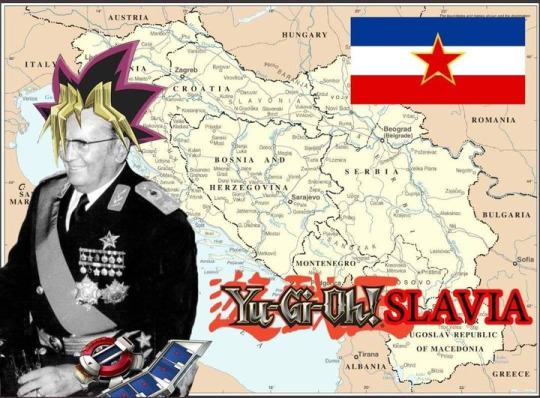
258 notes
·
View notes
Text

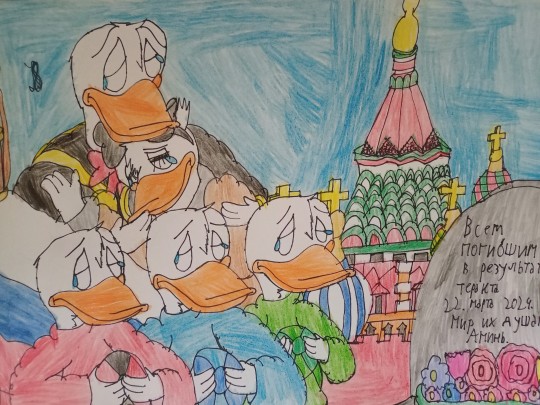
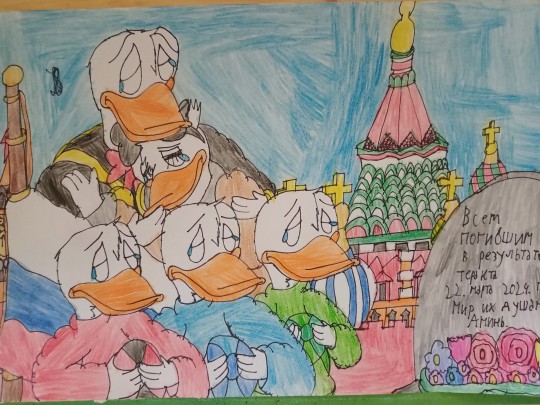
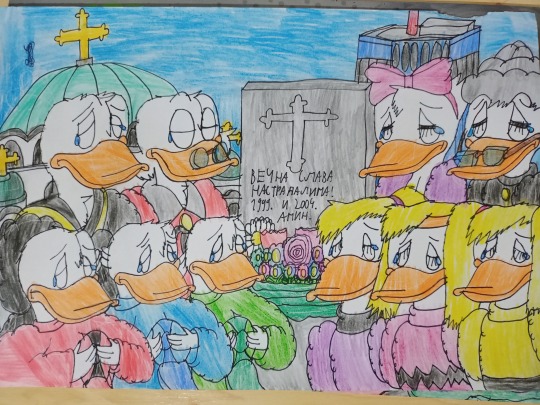
Donald Duck and his family mourn the dead in memory of the victims of the terrorist attack and bombing - Donald Duck and his family in Moscow (Russia) and Belgrade (Serbia) - Duck comics - Duckverse
Unfortunately, sorry for the long wait, because I was sick for a few weeks, and I'm recovering a bit now, so I haven't had a chance to draw and post new drawings. Yes, I'm back and will post follow-up drawings related to the previous holidays that were marked as well as the following holidays in the coming period.
Unfortunately, due to the recent events, I am publishing my sad drawings where Donald Duck and his family mourn the deceased. The first drawing shows Donald Duck with Daisy Duck, along with his nephews Huey, Dewey and Louie Duck who went to Moscow (the capital of Russia) and where they are mourning the dead and honoring the departed since a week ago (22.3. 2024) a terrorist attack took place in Moscow, in the Crocus City Hall, where over 140 people were killed and over 360 wounded. More could have been killed, if not for a few young men (Muslims and Russians) who saved the other people and took them out of the concert hall, because a concert by a Russian music group was about to take place. Among the dead were not only Russians, but also members of other nationalities who wanted to see that concert. The perpetrators are alleged Muslim terrorists from the Islamic State, and all of them were later caught. I don't want to go further into the discussion about the main principal who financed these terrorists, nor do I want to go into the discussion about the current war in Ukraine, because my blog is not about politics and please don't ask me those questions. This just shows my respect for the deceased not only the victims of that terrorist attack but also all the victims who died in terrorist attacks in the last more than 24 years. It is certainly a terrible event, which is why two days of mourning were declared after that, and I drew the Russian flag at half-mast, because on the day of mourning, the flag is only flown at half-mast, and Daisy in that drawing is wearing a coat and a black bow as a sign of mourning and black clothes are usually worn at funerals. Behind them, you can see the Basilica of St. Basil as well as the Spasskaya Tower, which is located within the Kremlin. Rest in peace to those victims.
Покойтесь с миром жертвы теракта! Слава им! Аминь.
The second drawing shows Donald with his family who are in Belgrade (the capital of Serbia) where they are mourning those who died and died during the bombing by NATO in 1999, as well as the victims in Kosovo and Metohija in 2004. I said that I come from Serbia and what happened 25 years ago was something that many residents of my country cannot forget. I was two years old when it started, so I don't remember it, except from the story of my parents. I don't want to go further into the discussion about the beginning of the war because the topic is too painful, and I doubt that many would understand what I would say. All in all, civilians did not deserve such a thing and it is very difficult to get over such wounds. Because among the dead there were also children who suffered from NATO bombing. There was also the courage of the soldiers who defended the country from the attackers and died bravely defending their country, so they are also honored. In addition to Donald, there are also Daisy Duck, Grandma Duck (Elvira Coot), Scrooge McDuck, Huey, Dewey and Louie Duck (Donald's nephews), April, May and June Duck (Daisy's nieces) where they pay tribute to those who died in that war as well as in the violence in Kosovo and Metohija that occurred in 2004, when there was also a mass exodus of Serbs, Roma, Bosniaks and other non-Albanian people from Kosovo and Metohija and the demolition of numerous Orthodox monasteries and churches by Albanian fanatics. Behind them is the Church of St. Sava, one of the largest Orthodox churches in the world, as well as the Beogradanka building, where one of Belgrade's television stations is located. On that grave is written the dedication to those victims as well as the flowers brought to that grave.
Rest in peace to those victims! Amen.
Вечна слава настрадалима и нека почивају у миру! Амин.
Also, since tomorrow is Good Friday, the day of the martyrdom of Jesus Christ, which is a sad day for Christians.
These are my tribute to those victims as well as those who suffered, and that the victims should not be forgotten and history should not be forgotten, because if it is forgotten, it will repeat itself again. Feel free to share this, but please do not use this for other people's purposes and please do not complicate it with political issues, because this blog is not dedicated to that. May God welcome the victims into the Kingdom of God and may they receive eternal glory! Rest in peace! Amen.
#my fanarts#tribute to victims#donald duck#duckverse#ducktales#russia#serbia#moscow#belgrade#yugoslavia#yugoslavia wars#Crocus City Hall attack#daisy duck#scrooge mcduck#grandma duck#elvira coot#huey dewey and louie#april may and june#artists on tumblr#huey dewey and louie duck#april may and june duck#disney ducks#disney duckverse#duck family#fanarts#rest in peace#amen#disney duck comics#duck comics#disney comics
46 notes
·
View notes
Text
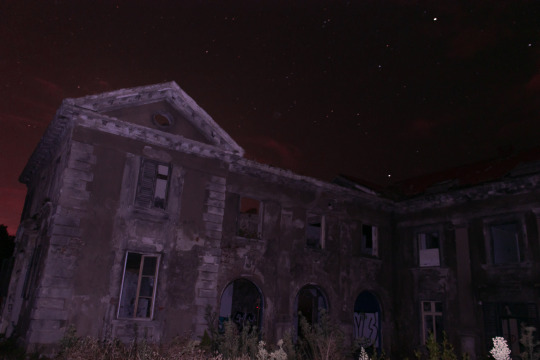
#night#abandoned#urbex#croatia#war#war ruins#homeland war#yugoslav wars#yugoslavia#kupari#grand hotel kupari#kupari grand hotel#stars#night sky#mine#hrvatska
1K notes
·
View notes
Text

#spomenik#star wars#monument#photography#architecture#lensculture#lensblr#photographers on tumblr#canon eos#archilovers#aesthetic#brutalist#brutalism#yugoslavia#montenegro#black and white
90 notes
·
View notes
Text
Milunka Savić, the Most Decorated Female Combatant in History: Savić disguised herself as a man in order to join the Serbian army during the Balkan Wars, then served again during WWI, earning medals from Serbia, France, Russia & Britain; she also provided medical support to anti-fascists during WWII and spent 10 months in a Nazi concentration camp
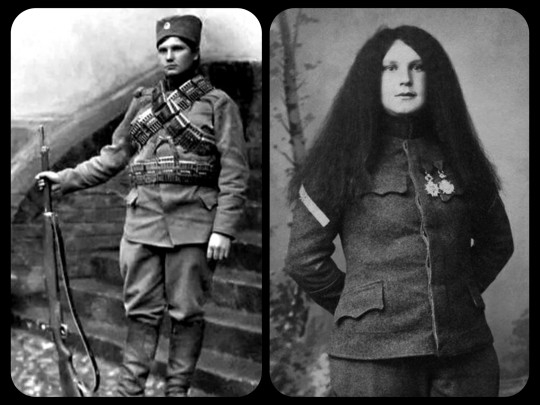
This is a total rewrite of a post that I did last year, with much more detailed information, more photos, and some additional sources.
Milunka Savić is regarded as the most decorated female combatant in history. She fought for the Serbian Army during both of the Balkan Wars, before returning to the battlefield again during WWI. Savić was wounded in battle on 9 separate occasions and survived the Serbian Great Retreat, making the perilous journey across the mountains of Montenegro and Albania through the dead of winter with a serious head injury.
Her military career began during the First Balkan War in 1912, when her younger brother was called up to serve in the Serbian army, and she decided that she would covertly take his place. She cut her hair, wore men's clothing, and presented herself as her brother.
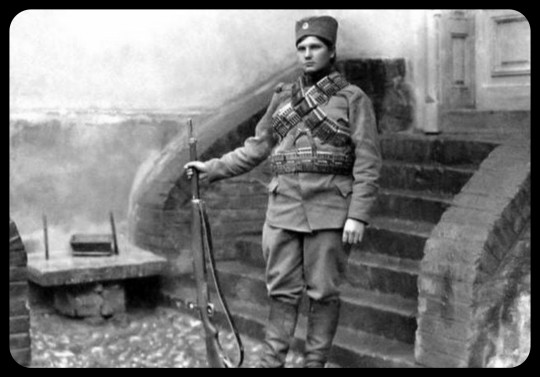
The First Balkan War, 1912: Milunka Savić as a young soldier during the First Balkan War, shortly after joining the Serbian army
She was able to hide her true identity for quite some time. Her skills as a soldier quickly became evident as the war progressed, and she earned her first medal/promotion during the Battle of Bregalnica in 1913. Unfortunately, she was hit by shrapnel from a Bulgarian grenade during her tenth deployment, causing injuries to her chest and abdomen, and those wounds (along with the subsequent medical treatment) ultimately led to the discovery that she had lied about her identity.
In recognition of her accomplishments on the battlefield, her commanding officer decided not to punish her for the initial deception, but informed her that she would not be allowed to return to combat -- as a woman, she could only be transferred to the nursing division instead.
As the story goes:
Savić was called before her commanding officer. They didn't want to punish her, because she had proven a valuable and highly competent soldier, and the military deployment that had resulted in her [sex] being revealed had been her tenth; but neither was it suitable for a young woman to serve in combat. She was offered a transfer to the Nursing division. Savić stood at attention and insisted that she only wanted to fight for her country as a combatant.
The officer said he'd think it over and give her his answer the next day. Still standing at attention, Savić responded, "I will wait." It is said he only made her stand an hour before agreeing to send her back to the infantry.
Savić was able to serve in a combat role throughout the remainder of the Balkan Wars.
The Second Balkan War finally came to an end in 1913, but that peace was short-lived, as World War I erupted just a year later. Savić returned to the military once more, serving in the elite "Iron Regiment" of the Serbian army.
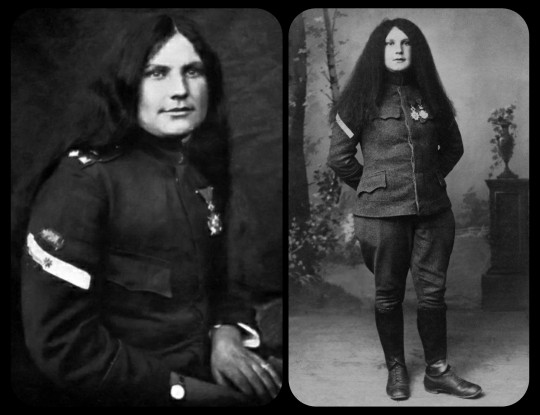
World War I, c.1915-1916: Savić was no longer forced to hide her identity when she returned to battle during WWI, and these images show her posing in uniform with her hair grown out
Savić received the Serbian Karađorđe Star with Swords medal on two separate occasions during WWI; the second medal was given to her after the Battle of Crna Bend in 1916, where she was credited with single-handedly capturing 23 Bulgarian soldiers. She received several other medals throughout the course of her career, including the French Legion of Honor (twice), the French Croix de Guerre, the Russian Cross of St. George, the British Medal of the Most Distinguished Order of St. Michael, and the Serbian Miloš Obilić.
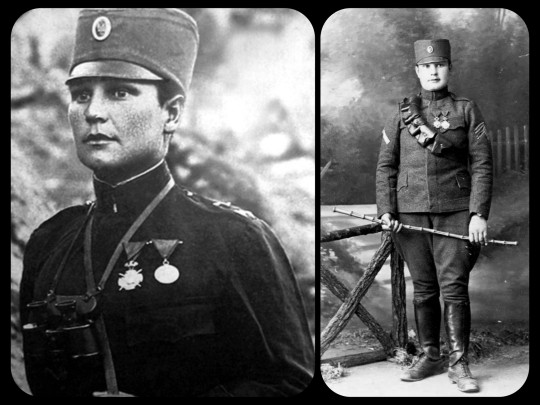
WWI, c.1915-1916: Milunka Savić as a Corporal in the Iron Regiment
She suffered a serious head injury while fighting along the Macedonian front, and she was still gravely wounded when Austro-Hungarian, German, and Bulgarian forces gained control of Serbia in the winter of 1915. The Serbian army was then ordered to make a full retreat from Serbia; Savić and her fellow soldiers, along with the Serbian government and more than 200,000 civilians, were all forced to flee through the mountains of Montenegro and Albania in the dead of winter, hoping to reach Allied forces along the Adriatic Coast -- a perilous journey that would later be known as the Serbian Great Retreat (or the Albanian Golgotha). Roughly 400,000 people embarked on this journey, and less than 180,000 of them survived, eventually reaching the Allied ships along the Adriatic coast.
Despite her injuries, Milunka Savić was among the survivors. She was sent to an infirmary, where she spent several months recovering from her injuries, before she returned to the battlefield alongside Allied forces.
At the end of the war, the French government offered to provide Savić with a full pension and living accommodations in France, in recognition of her actions while serving alongside the French military during WWI. She ultimately declined the offer and chose to retire back in Serbia instead, where she and her husband settled down to raise their daughter and three other girls that Milunka had adopted. The couple would later separate, however, and Milunka was left to raise her children as a single mother, working at a local bank to make ends meet.
In 1941, Serbia (which was then part of Yugoslavia) fell under Nazi occupation. During this period, Savić was involved in providing medical support to local partisans and anti-fascists who had resisted the Nazi occupation. She was eventually arrested by German officers; there are differing accounts of the events leading up to her arrest, with some sources suggesting that she was arrested as a result of her involvement with the local partisans and other anti-fascist elements, while other sources claim that she was arrested after she offended several Nazi officials by openly refusing to attend a formal banquet that was being held in honor of the German military campaign. In any case, she was imprisoned at the infamous Baljinca Concentration Camp for ten months before finally being released.
She faced other forms of hardship in the aftermath of WWII, as she struggled to support herself and her children. She worked several low-paying jobs over the years, while living in a dilapidated, decaying house in Belgrade. Her name (and her long list of accomplishments) had largely faded into obscurity by then.

Serbia, 1972: Milunka Savić proudly displaying some of her medals in 1972, when her story became more widely known
It wasn't until the early 1970s that her involvement with the military finally began to receive more widespread attention, both in Serbia and abroad. Following the 1972 publication of an article that told her story, her local community in Belgrade quickly rallied to provide her with newer, more suitable living arrangements.
Sadly, she passed away within just a year of the article's publication.
In 2013, Milunka Savić's remains were relocated from the small mausoleum where they had been interred since 1973, and she was reburied in Belgrade's "Alley of the Greats," where some of the most well-known and most widely respected Serbians are laid to rest.
Sources & More Info:
Research Gate: Milunka Savić: the Forgotten Heroine of Serbia
Girl Museum: Milunka Savić
Law and Politics: The Position of Women in the Serbian Army
Medium: The Fearless Woman-Bomber Who Died Proud, Broke, and Forgotten
Wikipedia: Milunka Savić
Mental Floss: The Serbian "Great Retreat" Begins (WWI Centennial)
#history#Milunka Savić#women in history#serbia#women in the military#balkans#military history#wwii#wwi#yugoslavia#milunka savic#challenging gender norms#feminism#femininity#serbian history#women's liberation#women in war#real-life mulan
159 notes
·
View notes
Text
By Stephen Millies
Twenty-five years ago — on the night of May 7-8, 1999 — the Embassy of the People’s Republic of China in Belgrade, Yugoslavia, was deliberately bombed by the U.S. Air Force.
This war crime was committed during the 78-day-long bombing of then-socialist Yugoslavia by NATO. Three Chinese journalists were killed. At least twenty were injured.
#imperialism#NATO#Yugoslavia#China#war crimes#embassy#bombing#Belgrade#anniversary#Struggle La Lucha
192 notes
·
View notes
Text
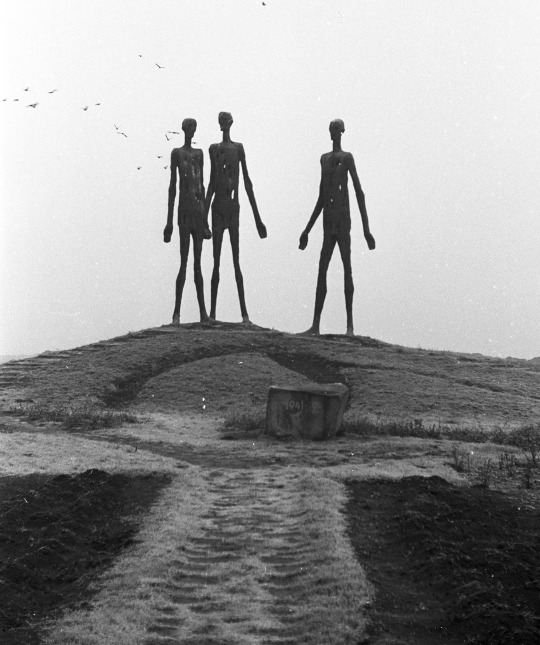
Memorial to the victims of the Novi Sad massacre, Serbia, 1968.
(Fortepan)
313 notes
·
View notes
Text

Group of female Yugoslav Partisans in Mount Dinara (near the border of present-day Bosnia-Herzegovina and Croatia) - 1943
185 notes
·
View notes
Text
Stop sending people to kill me. We've already captured five of them, one of them with a bomb and another with a rifle … If you don't stop sending killers, I'll send one to Moscow, and I won't have to send another.
— Josip Broz Tito (Yugoslavia) is reported to have written this in a letter to Joseph Stalin (USSR), around 1948-9.
28 notes
·
View notes
Text
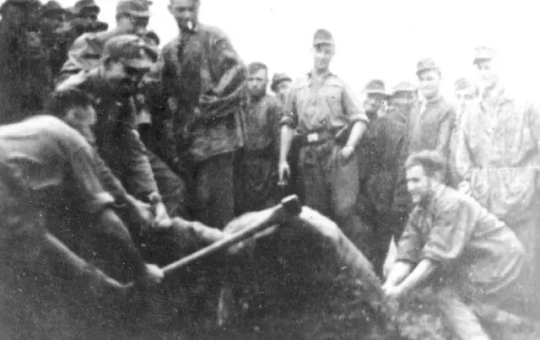



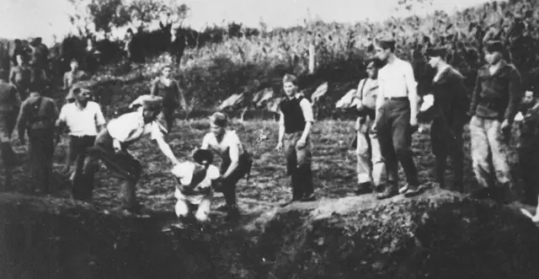
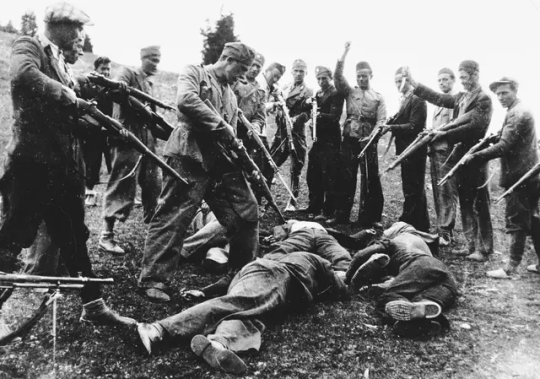
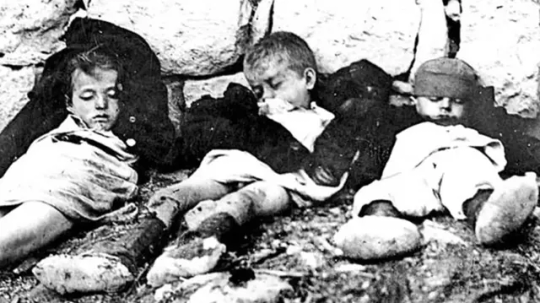
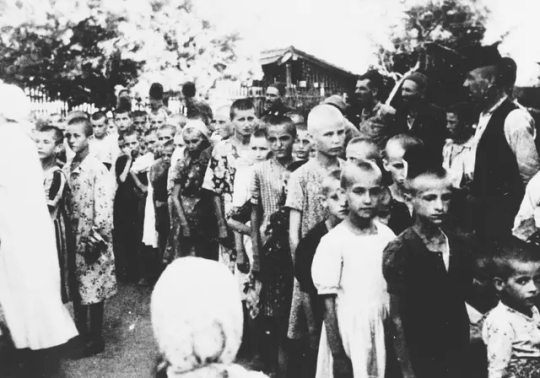
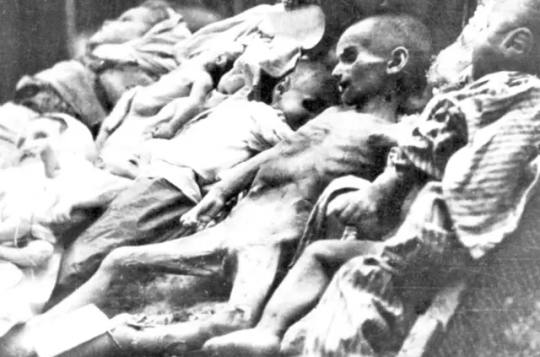
The Croatian Ustase was a fascist and ultranationalist organization that perpetrated the Holocaust and held up the Nazi regime in occupied Yugoslavia. Extremely brutal even for Nazi standards, the Ustaše went on to perpetrate the Holocaust and genocide against its Jewish, Serb and Roma populations, killing hundreds of thousands of Serbs, Jews, Roma, as well as Muslim and Croat political dissidents.
27 notes
·
View notes
Text
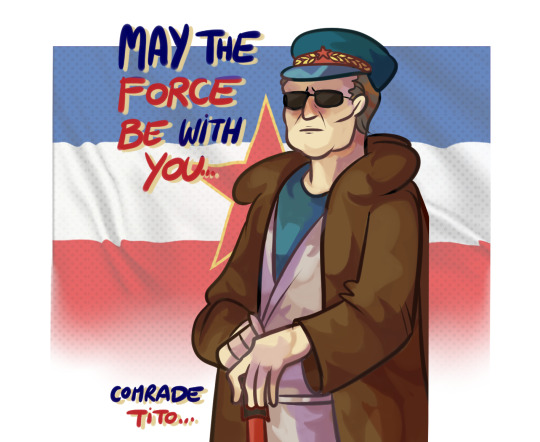
on 4th of may, 1980, a great man has died. rest in peace marshall your pioneers still live on... SF/SN
#art#illustration#josip broz tito#star wars#may the 4th#yugoslavia#croatia#serbia#bosnia and herzegovina#bosnia#montenegro#slovenia#communism#marxism#macedonia
60 notes
·
View notes
Text

11 December 1964, General Assembly of the United Nations, New York, USA
"Patria o Muerte!" - Homeland or Death
#che guevara#cuba#libertad por siempre#liberty#fatherland or dead#latin america#patria o muerte#libertarian#ex yugoslavia#yugoslav wars#montenegro#bosna#serbia#croatia#gospocki1001
29 notes
·
View notes
Text
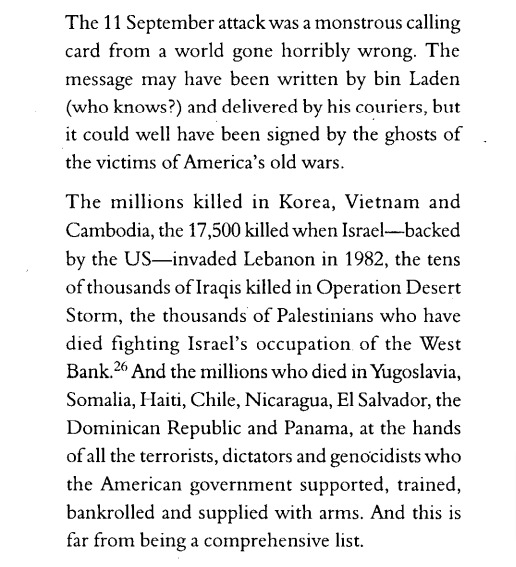
Arundhati Roy - The Algebra of Infinite Justice
#arundhati roy#the algebra of infinite justice#quote#september 11#9 1 1#korean war#vietnam#vietnam war#palestine#israel#cambodia#colonialism#imperialism#american imperialism#war#yugoslavia#politics#history#essay#book quotes#female writers#afghanistan#iraq#iraq war#trash
56 notes
·
View notes
Text
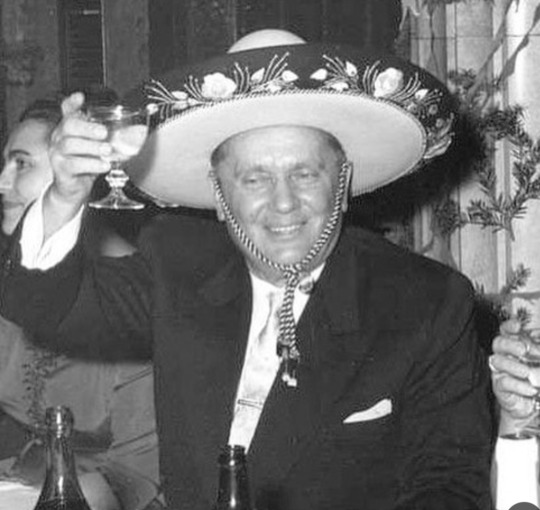

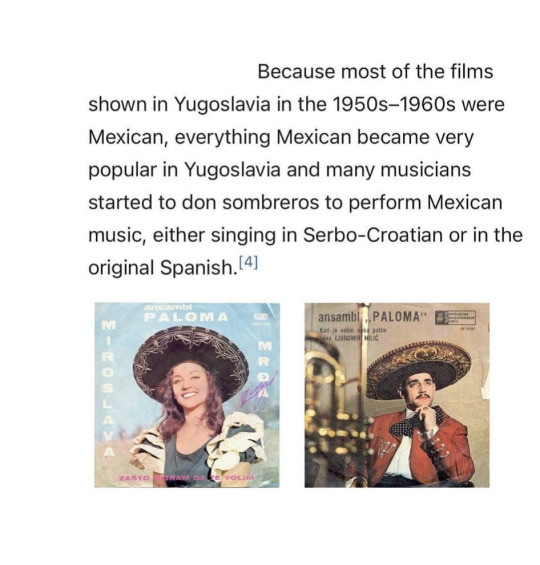

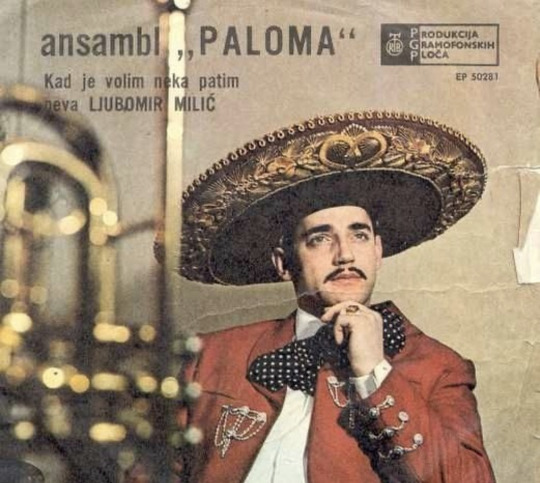

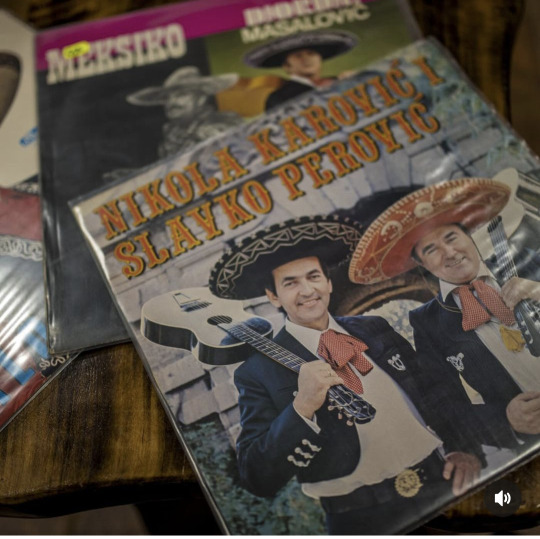
I actually knew a bunch of this because I'm weird and took a few classes on Yugoslavia in college (two, which was a lot considering my major was medieval studies), but the screenshots are entirely from here on Instagram: @aplasticplant.
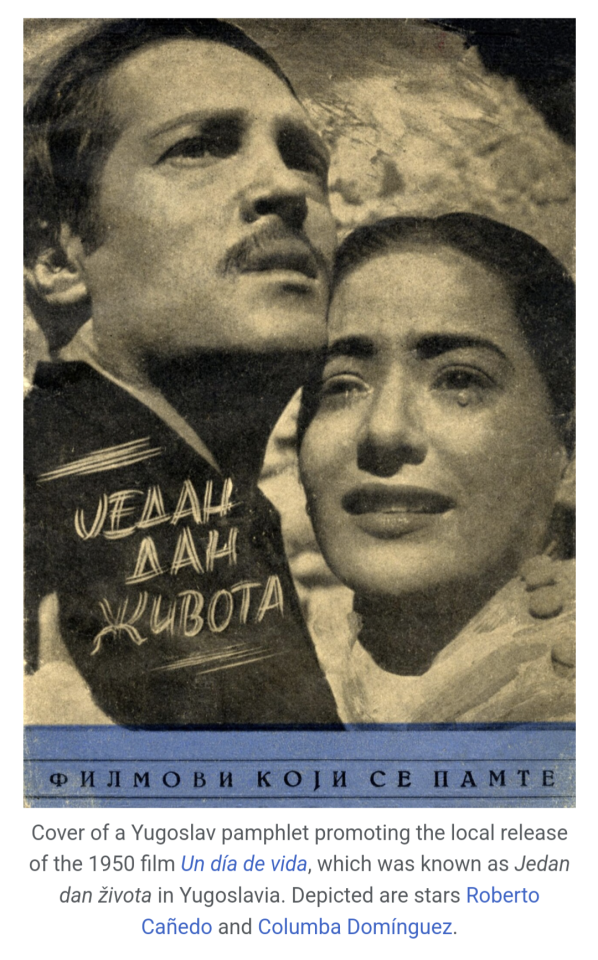

If you want to watch the Yu Mex documentary by Mazzini...
Here you go.
#yugoslavia#yu mex#tito#comrade tito#meanwhile in eastern europe#cold war#mexico#osterns#yugonostalgia#jugoslavija#Spotify
33 notes
·
View notes
Text

Monument dedicated to Serb and Albanian partisans, Mitrovica, Kosovo, 1973, designed by Bogdan Bogdanović. Photo by Ricardo Conte.
(Design Milk)
#kosovo#sculpture#architecture#military history#wwii#ww2#world war ii#world war 2#design#monument#serbia#albania#yugoslavia
264 notes
·
View notes
Text

August 7th panel for the r/Polandball Calendar Project 2024
The second biggest day in Operation Storm, a decisive battle that would lead Croatia to victory in its war for independence against Yugoslavia in 1995.
11 notes
·
View notes